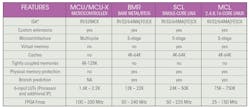Adding Soft-Core RISC-V to FPGAs Improves Programmability
What you’ll learn:
- Advantages of using a soft-core RISC-V processor.
- The type of performance you can expect from using a soft-core RISC-V processor on the Speedster 7t.
- A full list of configurable features available on Bluespec’s RISC-V soft cores.
RISC-V continues to garner more interest amongst the electronics design community, which has also led to many myths surrounding the technology. Much of the RISC-V implementation these days is hard core, often custom system-on-chips (SoCs), but that’s not the only way to get a RISC-V-based system.
FPGAs can implement almost any soft-core processor as long as there’s enough logic. The tradeoff is speed, space, and performance. FPGAs with soft-core RISC-V processors can handle real-time applications like robotics.
I talked with Loren Hobbs, VP Product and Business Development at Bluespec, about RISC-V and FPGAs.
What are the advantages of using a soft-core RISC-V processor?
There are many advantages to using a soft-core RISC-V processor in an FPGA, but one of the main advantages is that it allows you to manage your hardware resources with software. For instance, an application may call for the use of multiple hardware accelerators for specific workloads, which require sophisticated management. Think of a soft-core processor as an orchestra conductor that ensures the hardware is working together as intended.
Another advantage is that updating software in a design is much easier and less costly than updating hardware in a design that needs to be re-verified. It is also much easier to write simple software code to perform some functions that would be complex and time-consuming to implement in hardware. For example, finite state machines and control functions can grow in complexity as size increases, whereas these functions could be written in a few lines of C code.
>>Check out this TechXchange for similar articles and videos
Bluespec’s soft-core processors can be used in FPGAs and ASICs, offering design flexibility that proprietary soft-core processors do not offer. Our processors are configurable as well, providing further flexibility to tailor the processing implementation to the application requirements.
What applications do you see having the most adoption of soft-core processors?
Bluespec’s soft-core processors are general-purpose processors that can be used in most applications. Any application that has multiple accelerators that need to be managed is a good fit. Most of the commercial adoption to date has been in the mil/aero, data-center, and industrial markets.
What type of performance can you get from a soft-core RISC-V processor on the Speedster 7t?
Bluespec’s soft-core RISC-V processors run up to 300 MHz on the Achronix Speedster 7t family. Developers can also implement custom instructions to accelerate workloads that are computationally intensive or can be parallelized in FPGAs.
If developers add hardware with custom instructions, they can increase the performance to be orders of magnitude faster than just using the RISC-V standard instruction extensions. That’s what makes Bluespec’s processor so innovative—the customizability gives developers more flexibility to tailor application requirements based on the performance and resources available.
With Bluespec’s RISC-V processors, the Speedster7 FPGAs are ideal for high-bandwidth workloads, removing the performance bottlenecks associated with traditional FPGAs.
Are there particular features in the Achronix FPGA that you take advantage of?
Bluespec leverages several features in the Achronix Speedster 7t FPGA family. For example, Achronix’s 2D network-on-chip (NoC) is a high-speed hub within the chip that makes it easy for developers to drop in, connect to, and scale Bluespec’s RISC-V cores into the FPGA fabric, while maintaining performance.
The 2D NoC is able to rapidly scale computational capabilities by enabling efficient communication between different components within a chip or across multiple chips. Developers appreciate this scalability and the ability to customize instructions for specific implementations.
Bluespec is also leveraging hardened peripherals, such as the PCI Express Gen5 ports and memory controllers, on Achronix’s Speedster 7t FPGAs.
What type of features are configurable in the soft core, such as memory management and floating point?
Developers can take advantage of customizable instructions, extensions, and accelerators thanks to the configurability of Bluespec’s RISC-V soft cores. Other configurable features include cache size, floating-point support, and the number of instantiations, to name a few. Developers can also configure physical-memory protection and virtual-memory protection. A full list of configurable features can be found in the chart (see table).
Loren Hobbs, VP of Product and Business Development at Bluespec, has over 20 years of processor and programmable-logic design and marketing leadership experience at the world’s leading semiconductor companies, including Cypress Semiconductor, Intel, and NXP. He has designed, defined, and marketed multiple flagship product lines with over 1.5 billion devices sold. He’s passionate about bringing new products to market that solve the challenges of today by addressing the engineering barriers of the future.



